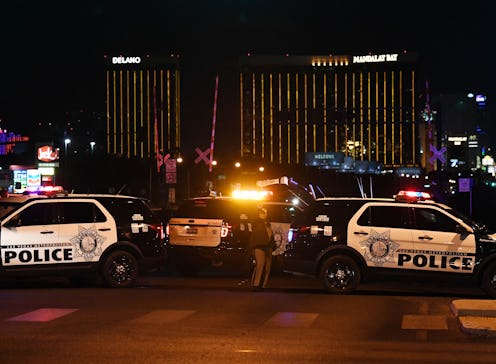News
These Are The Worst Las Vegas Hoaxes Being Shared Online

Late Sunday night, a mass shooting at a music festival in Las Vegas, Nevada, left 50 dead and more than 200 wounded. As word of the violence spread throughout the night, some have taken advantage of the chaos to post Las Vegas shooting hoaxes — particularly misinformation about the identities of victims and the shooter. According to BuzzFeed, which published a running list of these hoaxes Monday morning, these "reports" began circulating on Twitter mere minutes after the news broke online. Unfortunately, the nature of the internet makes it difficult to tell truth from fiction at times, and some trolls have taken advantage of that.
The event took place around 10 p.m. local time at the Route 91 Harvest Festival. According to the Las Vegas Police Department, the shooter opened fire from a room on the 32nd floor of a nearby hotel on a crowd of more than 22,000 concertgoers. At time of writing, more than 200 were injured and 50 dead in the aftermath of the violence, making it deadlier than the Pulse nightclub shooting in June 2016. Police have confirmed that the suspected shooter is dead, and a woman who appears to be his "companion" has been located.
On Monday morning, many people took to social media to express their condolences for the victims, but others chose to spread untruths. One common hoax was tweeting a picture of comedian Sam Hyde, claiming he was the shooter.
One variation on the hoax declares that his name is Samir al-Hajeed or Samir al-Hajib, and he converted to Islam. As some have pointed out, these names are simply variations on Sam Hyde.
However, Las Vegas police have identified the suspected shooter, and he was certainly not the founder of the internet sketch group Million Dollar Extreme. In fact, this isn't the first time Hyde has been identified as the gunman in a mass shooting. In the last few years, "Sam Hyde is the shooter" has become a meme, and his photograph has been circulated after the 2015 San Bernardino shooting, the 2017 London terror attacks, and more. Basically, if you see any photograph of Hyde linked to mass violence, take it with a grain of salt.
In addition, fake photos of missing people and victims are being shared online. As BBC News reports, some accounts have posted photographs of a young man they claim is their brother, who was last seen in Las Vegas. However, the teenager in these photos is actually a food blogger known as "Reviewbrah." He was falsely named as a victim of the Manchester Arena bombing this year, a hoax he was forced to clear up in a video titled "I am alive." BBC News approached one of these accounts to ask why they wrote that "Reviewbrah" was their missing brother, but they never responded. Meanwhile, the tweet remains online.
Similarly, another account shared a picture of Vine star Lil Terio in a now-deleted tweet, claiming the child is their missing nephew. Yet another troll account posted photographs of a young blonde woman they called "Taylor Joshuas"; as it turns out, the pictures were taken from Twitter user @naught4y.
Judging from her response to discovering how her photographs were being used, she is alive and well.
Photographs of athletes, porn stars, and even murder suspects have been shared as hoaxes as well. This, for instance, is actually Belgian soccer player Eden Hazard.
Then there are the conspiracy theories. Currently, one of the most prevalent among right-wing news sites is that the shooter is a left-leaning man named Geary Danley, which has been decidedly disproven. There have also been rumors that the attack was motivated by political or religious affiliations, although police have not come forward with any information in that regard yet.
So how are you supposed to avoid being taken in by misinformation? Simply put, remain skeptical. NPR has an extensive guide to spotting fake news that's worth reading, but the gist is this: If you're reading a post on social media, check out the account that shared or wrote it. Most of the time, you can spot a troll account by looking through the rest of their content. If it seems like a throwaway account, or it often posts reactionary content, the account is probably not all that reputable. It's also vital to check with multiple, objective news sources rather than relying on a single article to fill you in.
Finally, think twice before sharing anything from other users unless you're certain it's the truth. In 2017, that's harder than you would think.
Here are some ways you can help the victims in Las Vegas.